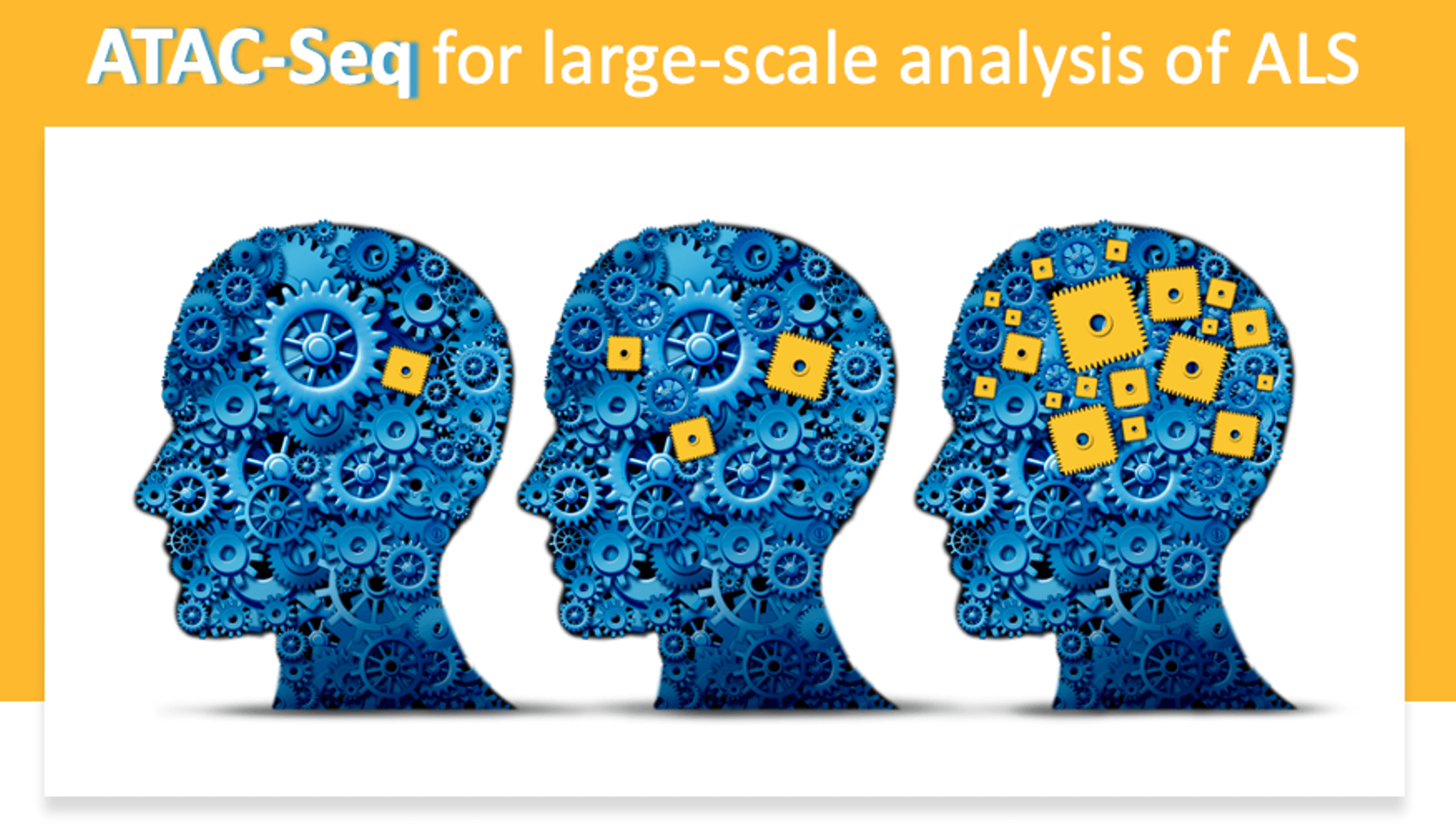<< Back to MOTIFvations Blog Home Page
Exploring ALS (Amyotrophic Lateral Sclerosis) with iPSCs and ATAC-Seq

December 12, 2024
Table of Contents:
Introduction: The Unknowns of Amyotrophic Lateral Sclerosis
While estimates for the heritability of amyotrophic lateral sclerosis (ALS) (van Es et al.) - a neurodegenerative disorder characterized by the significant loss of motor neurons – can be as high as 50% (Ryan et al.), known genetic factors account for only a small fraction of cases. To gain a deeper appreciation of the onset and development of sporadic ALS, researchers guided by Ernest Fraenkel (MIT) evaluated motor neurons differentiated from induced pluripotent stem cells (iPSCs) generated from the peripheral blood mononuclear cells (PBMCs) of a diverse group of ALS patients and healthy controls (Tsitkov et al.), thanks to the immense efforts of the Answer ALS consortium (Baxi et al.).
Assay for transposase-accessible chromatin using sequencing or ATAC-Seq (Buenrostro et al.) represented the epigenetic tool employed in this study to identify genetically driven, disease-associated alterations in chromatin accessibility. Previous studies had highlighted the influence of epigenetic mechanisms in ALS pathology (Chestnut et al., Tibshirani et al., and Cobos et al.); as such, the identification of additional disease-associated epigenetic signatures would aid the understanding of pathological mechanisms and highlight potential therapeutic targets. The application of ATAC-Seq in this study demonstrated that iPSC-derived motor neurons display ALS-relevant alterations that reflect disease-associated variation at the genetic and clinical levels (Tsitkov et al.). Of note, this study reports one of the largest bulk ATAC-Seq datasets generated by a single consortium and the largest bulk ATAC-Seq dataset overall from cell cultures of different donors when applying a single differentiation protocol.
Correcting Covariates to Identify Differences in Chromatin Accessibility by ATAC-Seq
Tsitkov et al. revealed that clinical covariates (sex and ancestry), differentiation-associated covariates (iPSC cell type of origin from PBMCs), and sequencing-associated covariates (the “fraction of reads in peaks” score and the read length employed, reflecting sequencing efficiency) all significantly influenced ATAC-Seq findings (Tsitkov et al.), although the team expected this result given the study of a hugely diverse population over a period of several years.
The initial analysis of chromatin accessibility profiles failed to encounter any differences when comparing familial and sporadic ALS cases with controls, a finding consistent with the known variability in ALS etiology and phenotypes; however, correcting for the identified covariates supported the identification of a difference in chromatin accessibility at the C9orf72 transcriptional start site in ALS cases that harbor the mutant C9orf72 hexanucleotide repeat expansion, a significant risk factor for familial ALS (Li et al.). Of note, this encouraging finding supports the hypothesis that haploinsufficiency of the C9orf72 transcript contributes to ALS (Shi et al.).
Interestingly, the ATAC-Seq data of iPSC-derived motor neurons collected from ALS patients could also be employed to predict ALS disease progression rates with similar or better accuracy to alternative previously described methods based on biomarkers and clinical status.
The Value of Large-scale ATAC-Seq Studies in ALS iPSC-derived Cells
This vast undertaking highlights the considerable value of analyzing chromatin accessibility profiles in motor neurons differentiated from iPSCs generated from ALS patients; overall, these motor neurons appear to recapitulate disease-relevant epigenetic alterations, which can reflect genetic and clinical variation in the disease. The authors note that this success now provides the impetus to integrate these data with other omics modalities to open new avenues of research and help guide the way toward safe and effective therapeutic approaches for this devastating disease.
For more on how ATAC-Seq analysis of iPSC-derived motor neurons has supported a better understanding of ALS, see Nature Communications, May 2024.
About the author

Stuart P. Atkinson, Ph.D.
Stuart was born and grew up in the idyllic town of Lanark (Scotland). He later studied biochemistry at the University of Strathclyde in Glasgow (Scotland) before gaining his Ph.D. in medical oncology; his thesis described the epigenetic regulation of the telomerase gene promoters in cancer cells. Following Post-doctoral stays in Newcastle (England) and Valencia (Spain) where his varied research aims included the exploration of epigenetics in embryonic and induced pluripotent stem cells, Stuart moved into project management and scientific writing/editing where his current interests include polymer chemistry, cancer research, regenerative medicine, and epigenetics. While not glued to his laptop, Stuart enjoys exploring the Spanish mountains and coastlines (and everywhere in between) and the food and drink that it provides!
Contact Stuart on Twitter with any questions
Related Articles
Parkinson's Disease Described at Single-cell Epigenetic & Transcriptomic Level
June 21, 2024
Paired transcriptomic and epigenetic analyses in single brain cells has illuminated which cells and what mechanisms are involved in age-related neurodegenerative disorders. Thanks to new research from the Yoshiaki Tanaka lab at Université de Montréal and Yoon-Seong Kim at Rutgers University. We present an overview of how they employed this paired profiling to post-mortem brain samples to explore the mechanisms involved in normal aging and Parkinson's disease development!
Read More
Multiomics (RNA-Seq and ATAC-Seq) Forge the Way Towards a Better Understanding of Type 2 Diabetes
November 6, 2024
A fascinating new study from researchers at the Jackson Laboratory and led by Duygu Ucar and Michael Stitzel combines transcriptomic and chromatin accessibility profiling in human pancreatic islet cells to gain new epigenetic insight into the pathogenesis of type 2 diabetes. Their multiomic approach incorporates both ATAC-Seq and RNA-Seq for complete picture of gene expression.
Read More
<< Back to MOTIFvations Blog Home Page








